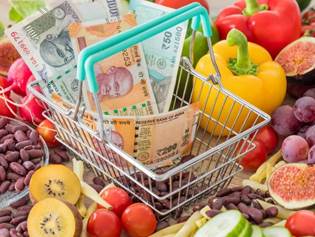Description

Disclaimer: Copyright infringement not intended.
Context
- Retail inflation fell below 6% mark for first time in 2022.
Retail inflation
- Retail inflation tracked by the Consumer Price Index (CPI) measures the changes in prices from a retail buyer's perspective.
- Wholesale inflation on the other hand is tracked by the Wholesale Price Index (WPI), measures inflation at the level of producers.
Recent Findings
Vegetables and Edible Oil
Cooling vegetable and edible oil prices drove India’s retail inflation down to 5.88% in November from 6.77% in October, the first time since January this year that consumer prices have risen slower than the 6% tolerance threshold set for the central bank.
.jpg)
Food price inflation
Food price inflation faced by consumers eased to an 11-month low of 4.67% from over 7% in October, but rural consumers faced a greater burden with a 5.2% price rise in food items, compared to just 3.7% for their urban peers. Overall rural retail inflation also stayed high at 6.09%.
Cereals and milk inflation
Cereals and milk inflation, the top two contributors to food inflation, are still elevated and on an upward trend, while the upward pressure on services inflation has strengthened core inflation.
Core Inflation
Inflation in the major components of core inflation - transportation and communication, housing, households good and services — was up or remained stable on-year, indicating continued passthrough of input prices and recovering demand.
Consumer Price Index (CPI)
- Consumer Price Index (CPI) measures the inflation at retail level.
- Consumer Price Index (CPI) is a measure of change in retail prices of goods and services consumed by people in a given area with reference to a base year. CPI is calculated for a fixed list of items including food, housing, apparel, transportation, electronics, medical care, education, etc. The price data is collected periodically, and thus, the CPI is used to calculate the inflation levels in an economy.
The main uses of CPI are the following:
- It is widely considered as a barometer of inflation
- Tool for monitoring price stability
- The Reserve Bank of India is now using CPI(Combined) as the as the benchmark for its monetary policy tools like Repo Rate, Reverse Repo Rate.
- According to the Agreement on Monetary Policy Framework signed between the Government and the RBI in 2015 the sole objective of the RBI is price stability and the Consumer Price Index (Combined) is measured as the target inflation.
Consumer Price Index compiled for four groups of consumers in India:
- CPI for Industrial workers CPI(IW)
- Consumer Price Index for Urban Non-Manual Employees (UNME)
- CPI for Agricultural Labourers CPI(AL)
- CPI for Rural Labourers CPI(RL)
- While the Ministry of Statistics and Program Implementation collects CPI (UNME) data and compiles it, the remaining three are collected by the Labour Bureau in the Ministry of Labour.
.jpg)
Inflation Targets
- Targeted consumer price index (CPI) inflation rate is= 4%
- Upper tolerance limit of inflation is= Target inflation rate + 2% = (4% + 2%) =6%
- Lower tolerance limit of inflation is= Target inflation rate – 2% = (4% – 2%) =2%
- Targeted consumer price index (CPI) inflation rate period from = April 1, 2021
- Targeted consumer price index (CPI) inflation rate period up to = March 31, 2026
Monetary policies can target inflation levels. A low level of inflation is considered to be healthy for the economy. If inflation is high, a contractionary policy can address this issue.
https://www.thehindu.com/business/Economy/retail-inflation-falls-below-6-mark-for-first-time-in-2022/article66254764.ece






.jpg)







